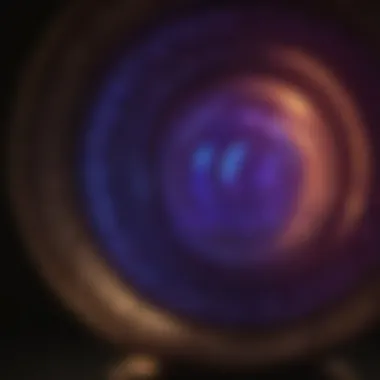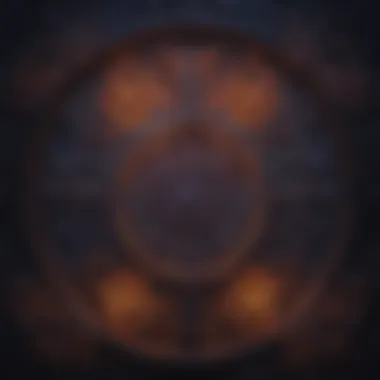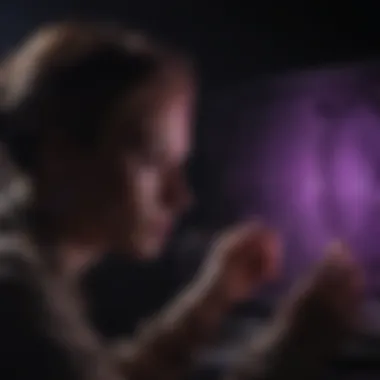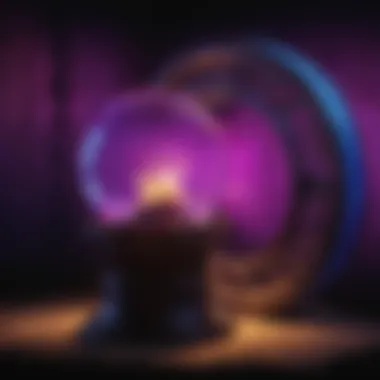Unveiling the Intriguing Universe of Blacklight Lamps: A Comprehensive Exploration


Rock and Fossil Identification
Blacklight lamps play a crucial role in the identification of rocks and fossils by revealing unique fluorescent properties. When it comes to rocks, various types such as igneous, sedimentary, and metamorphic showcase distinctive characteristics that are brought to light under UV rays. Fossils, too, emit distinct fluorescent glows that aid in their differentiation. To effectively identify these specimens, enthusiasts should look for specific characteristics like brightly colored fluorescence, patterns, or mineral composition alterations when exposed to blacklight. Utilizing specialized tools such as portable UV lights or UV torches enhances the identification process, allowing collectors to discern subtle differences not visible under regular lighting conditions.
Geological Insights
Introduction to Blacklight Lamps
In this article, we embark on a journey to unravel the mysteries and functionalities of blacklight lamps, shedding light on their diverse uses and applications. As we delve into the realm of UV technology, we aim to provide a thorough understanding of how blacklight lamps operate and their significance across various industries. By exploring the intricacies of blacklight technology, we can appreciate the pivotal role these lamps play in enhancing fluorescence detection and expanding the horizons of scientific exploration.
Understanding Blacklight Technology
Definition of Blacklight Lamps
The cornerstone of blacklight technology lies in the definition of blacklight lamps, which are specialized lighting devices emitting ultraviolet (UV) light in the 315-400 nanometer range. These lamps create a unique fluorescent effect by stimulating certain substances to glow in the dark, uncovering hidden details and spectral phenomena not visible under standard lighting conditions. The distinct characteristic of blacklight lamps is their ability to reveal fluorescence, making them a valuable tool in forensics, entertainment, and scientific research.
Principles of Ultraviolet Light Emission
The principles governing ultraviolet light emission elucidate the mechanism behind blacklight lamps' ability to generate UV radiation. By exciting phosphors or materials with high UV-reactivity, these lamps produce electromagnetic waves that fall outside the visible spectrum, amplifying their fluorescence-detection capabilities. While advantageous for revealing hidden patterns and substances, the emission of UV light poses potential health hazards if not handled with care, necessitating a balance between utility and safety precautions.
Types of Blacklight Lamps
Fluorescent Blacklight Lamps
Fluorescent blacklight lamps are a popular choice due to their efficiency in producing UV light and creating vibrant fluorescent effects. Their ability to emit light across the UV-A spectrum makes them ideal for diverse applications, from party decorations to scientific analysis. However, fluorescent lamps have limitations in terms of lifespan and intensity, requiring periodic replacement and calibration to maintain optimal performance.
LED Blacklight Lamps
LED blacklight lamps have revolutionized the industry with their durability, energy efficiency, and compact design. By leveraging light-emitting diodes to generate UV radiation, these lamps offer portability and longevity compared to traditional fluorescent models. While LED lamps excel in energy savings and prolonged use, their intensity and coverage may vary based on design and manufacturing standards, influencing their suitability for different settings.
Incandescent Blacklight Lamps
Incandescent blacklight lamps, though less common in modern applications, provide a nostalgic charm and warm glow reminiscent of classic blacklight displays. Their reliance on heated filaments to produce UV light gives them a unique aesthetic appeal but limits their efficiency and lifespan compared to newer technologies. Balancing aesthetics with performance, incandescent lamps cater to niche markets focusing on ambiance and ambiance enhancement rather than precision UV applications.


Applications of Blacklight Lamps
Forensic Investigations
The use of blacklight lamps in forensic investigations extends beyond crime scene analysis to include DNA detection, counterfeit currency verification, and artwork authentication. By harnessing the fluorescence of biological and chemical samples under UV light, forensic experts can uncover hidden traces and anomalies crucial for case resolution. The non-invasive nature of blacklight examination enhances the efficiency and accuracy of forensic procedures, making it an indispensable tool in law enforcement and investigative practices.
Germ Detection in Medical Settings
Blacklight lamps play a pivotal role in germ detection within medical settings, illuminating bacteria and contaminants invisible to the naked eye. By highlighting areas of potential infection or poor sanitation, healthcare professionals can implement targeted cleaning measures and infection control protocols. The rapid and accurate detection facilitated by blacklight lamps enhances hygiene standards and reduces the risk of nosocomial infections, safeguarding patient well-being in clinical environments.
Mineral Identification in Geology
In the field of geology, blacklight lamps aid in mineral identification by revealing unique fluorescence patterns specific to different minerals and crystals. This fluorescence phenomenon, known as mineral fluorescence, assists geologists in distinguishing minerals based on their composition and optical properties. By subjecting rocks and specimens to UV light, geologists can classify and analyze mineral samples with precision, contributing to geological research, exploration, and mineralogical study.
Benefits and Limitations of Blacklight Lamps
In this section, we delve into the vital aspects of blacklight lamps, outlining both their advantages and challenges. Understanding the benefits and limitations of blacklight lamps is crucial for grasping their full potential in various applications. Blacklight lamps offer unique advantages, such as enhanced fluorescence detection and versatility in usage, but they also present limitations like limited penetration depth of UV light and potential eye and skin hazards that demand careful consideration.
Advantages of Using Blacklight Lamps
Enhanced Fluorescence Detection:
Enhanced fluorescence detection is a pivotal feature of blacklight lamps, enabling the visualization of fluorescent materials that are typically invisible to the naked eye. This capability plays a significant role in various fields ranging from forensics to mineral identification, allowing for the detection of hidden clues and substances under UV illumination. The heightened sensitivity of blacklight lamps in detecting fluorescence enhances the efficiency and accuracy of inspections and analyses, making them indispensable tools in investigative and diagnostic processes.
Versatility in Applications:
Blacklight lamps exhibit remarkable versatility in their applications, catering to a diverse range of industries and purposes. Their ability to emit UV light across different wavelengths opens up numerous possibilities, from illuminating fluorescent minerals in geology to detecting germs in medical settings. This adaptability underscores the broad utility of blacklight lamps, making them indispensable across various fields where UV fluorescence is utilized.
Challenges Faced with Blacklight Lamps
Limited Penetration Depth of UV Light:
The limited penetration depth of UV light emitted by blacklight lamps poses a notable challenge, particularly in scenarios where thorough inspection or visibility beyond surface-level is required. The nature of UV light restricts its ability to penetrate deep into materials, which can hinder the detection of fluorescence within opaque or dense substances. This limitation underscores the need for supplemental lighting sources or alternative techniques to overcome constraints related to penetration depth when using blacklight lamps.
Potential Eye and Skin Hazards:


Another significant consideration with blacklight lamps is the potential hazards they pose to the eyes and skin upon prolonged exposure. The high-energy UV radiation emitted by these lamps can be harmful if proper precautions are not taken, leading to risks of eye irritation, skin burns, or long-term health effects. Mitigating these risks requires strict adherence to safety guidelines, including wearing protective eyewear and limiting direct exposure to UV light, emphasizing the importance of responsible usage practices with blacklight lamps.
Factors to Consider When Choosing a Blacklight Lamp
When delving into the realm of blacklight lamps, it becomes evident that selecting the right lamp is crucial for optimal performance. Several key factors should be taken into account to ensure the chosen lamp meets the specific requirements of the intended application. Understanding these elements not only enhances the efficiency of the UV light source but also plays a significant role in achieving the desired results.
Wavelength and Intensity
Optimal UV Wavelength for Specific Applications
Exploring the realm of optimal UV wavelengths unveils a critical aspect of blacklight lamps selection. The wavelength of UV light emitted by the lamp determines its effectiveness in various applications, such as fluorescence detection or mineral identification. By choosing the appropriate UV wavelength tailored to the specific task at hand, individuals can maximize performance and accuracy. The selection of the optimal UV wavelength plays a pivotal role in the success of blacklight applications, ensuring precise results and efficient outcomes.
Measuring UV Light Intensity
Understanding how to measure UV light intensity is fundamental in selecting the right blacklight lamp. The intensity of UV light emitted by the lamp directly impacts its effectiveness in different scenarios, ranging from mineral identification to germ detection. By assessing and comparing UV light intensities of various lamps, users can pinpoint the most suitable option for their specific needs. Measuring UV light intensity facilitates informed decision-making, enabling users to choose blacklight lamps that align perfectly with their requirements.
Portability and Durability
Compact vs. Industrial-grade Blacklight Lamps
The choice between compact and industrial-grade blacklight lamps represents a crucial decision-making point for users. While compact lamps offer portability and convenience, industrial-grade models guarantee durability and prolonged usage. Evaluating the trade-offs between portability and durability is essential to identify the most suitable lamp for individual preferences and requirements. The decision between compact and industrial-grade blacklight lamps ultimately dictates the user experience and longevity of the chosen lamp.
Impact-resistant Materials
The consideration of impact-resistant materials underscores the significance of durability in blacklight lamp selection. Opting for lamps constructed from impact-resistant materials ensures longevity and resilience in diverse environments. Such materials protect the lamp against potential damage, guaranteeing sustained performance and reliability. Highlighting the importance of impact-resistant materials sheds light on the essential aspect of durability in the context of blacklight lamp usage.
Maintenance and Safety Tips for Blacklight Lamps
Maintenance and safety tips are crucial elements to consider when delving into the world of blacklight lamps. In this comprehensive guide, the focus on maintenance and safety aims to enhance the longevity and efficiency of blacklight lamps while ensuring user well-being.
Cleaning and Storage Practices
Avoiding Dust Accumulation on Lenses


When it comes to blacklight lamps, one specific aspect that merits attention is avoiding dust accumulation on lenses. This practice contributes significantly to maintaining the optimal performance of the lamps. Dust particles can obstruct the UV light emitted by the lamp, diminishing its effectiveness in fluorescence detection. By regularly cleaning the lenses and preventing dust buildup, users can ensure clear and potent UV light output essential for various applications. The meticulous care in this aspect showcases dedication towards maximizing the utility of blacklight lamps in this article.
Proper Storage to Avoid Breakage
Proper storage is another critical aspect concerning blacklight lamps to avoid breakage and maintain their integrity. Storing the lamps in a secure and structured manner minimizes the risk of accidental damage, such as falls or impacts. Choosing suitable storage spaces that are free from potential hazards ensures the longevity of the lamps, safeguarding them from unnecessary wear and tear. Emphasizing proper storage practices not only protects the investment in blacklight lamps but also guarantees their readiness for use whenever required, making it a smart and prudent choice for readers of this article.
Safety Precautions During Usage
Wearing Protective Eyewear
Addressing safety precautions during the usage of blacklight lamps includes the essential practice of wearing protective eyewear. Protective eyewear shields the eyes from exposure to harmful UV rays emitted by the lamps, safeguarding the user's vision and preventing potential eye damage. The emphasis on employing protective eyewear underscores the significance of prioritizing personal safety while engaging with blacklight technology. Describing the intricacies and benefits of using protective eyewear ensures a heightened awareness of safety measures among enthusiasts and professionals exploring blacklight lamps in this informative article.
Limiting Exposure Time to UV Light
Implementing limits on exposure time to UV light is a fundamental safety measure tied to the usage of blacklight lamps. Excessive exposure to UV light can pose risks to skin health, potentially causing burns or long-term damage. By setting boundaries on the duration of UV light exposure during lamp use, individuals can mitigate the adverse effects and uphold their well-being. Advocating for the responsible and controlled use of blacklight lamps ensures a balance between utility and safety, promoting a secure and informed approach to leveraging this technology for varied applications. Incorporating measures to limit exposure time serves as a proactive step towards maintaining health and safety standards in the realm of blacklight lamp utilization.
Exploring Innovative Trends in Blacklight Lamp Technology
Innovation in blacklight lamp technology plays a pivotal role in pushing the boundaries of conventional UV light applications. This section delves into the cutting-edge advancements that are reshaping the landscape of blacklight lamps, catering to the evolving needs of industries and consumers alike. By examining the latest trends, we aim to provide insights into the future direction of blacklight technology.
Integration with Smart Home Systems
Voice-activated Blacklight Lamps
The integration of voice-activated technology into blacklight lamps represents a significant leap towards user convenience and accessibility. With voice commands, users can effortlessly control the activation and intensity of blacklight lamps, enhancing user experience and functionality. This feature not only simplifies the operation of the lamps but also aligns with the modern trend of smart technologies infiltrating daily living environments. The streamlined operation and hands-free control offered by voice-activated blacklight lamps make them a compelling choice for tech-savvy enthusiasts seeking seamless integration within their smart home systems.
App-controlled UV Light Settings
App-controlled UV light settings empower users with a high level of customization and precision over their blacklight lamps. By allowing users to adjust settings such as intensity levels, timers, and color variations through a dedicated mobile application, these lamps offer unparalleled flexibility. The unique ability to tailor the UV light output to specific requirements or preferences enhances the practicality and versatility of these lamps. While offering convenience and customization, app-controlled UV light settings do come with the potential challenge of compatibility issues or connectivity concerns. However, the advantages of precise control and personalized settings outweigh these minor drawbacks, making them a valuable addition to the blacklight technology landscape.
Advancements in Energy Efficiency
The evolution of blacklight lamps towards enhanced energy efficiency is a critical development that addresses sustainability and cost-effectiveness. This section delves into the contrasting aspects between LED blacklight lamps and traditional models, shedding light on the advantages and limitations of each. It also explores the innovative approach of solar-powered blacklight options, pioneering a greener and more eco-friendly direction for UV light applications.
LED Blacklight Lamps vs. Traditional Models
The transition from traditional blacklight models to LED variants signifies a significant advancement in energy efficiency and performance optimization. LED blacklight lamps consume less power, generate minimal heat, and have an extended lifespan compared to their traditional counterparts. Their compact size and enhanced durability make them a preferred choice for various applications, ranging from industrial to residential settings. Despite the higher initial cost of LED lamps, their long-term savings and eco-friendly profile position them as a desirable choice for environmentally conscious consumers and businesses.
Solar-powered Blacklight Options
Harnessing solar energy for powering blacklight lamps presents a sustainable and eco-conscious solution in the realm of UV light technology. Solar-powered blacklight options not only reduce dependency on conventional power sources but also contribute to environmental preservation. By leveraging renewable energy sources, these lamps offer a greener alternative while maintaining optimal performance standards. The autonomy and self-sufficiency provided by solar-powered blacklight options align with the global shift towards sustainable practices, making them a compelling choice for conscientious users looking to minimize their carbon footprint.







